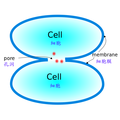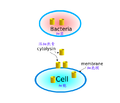Cytolysin
Cytolysin is a type of toxin produced by certain bacteria that is capable of lysing cells by forming pores in the cell membrane. This process is known as cytolysis, which can lead to cell death. Cytolysins are a major virulence factor for many pathogenic bacteria.
Types of Cytolysin[edit]
There are several types of cytolysins, each with unique properties and mechanisms of action. Some of the most well-known include:
- Streptolysin: This is a cytolysin produced by Streptococcus bacteria. There are two types: Streptolysin O and Streptolysin S. Streptolysin O is oxygen-labile and antigenic, while Streptolysin S is oxygen-stable and non-antigenic.
- Listeriolysin O: This is a cytolysin produced by Listeria monocytogenes, a bacterium that causes listeriosis. Listeriolysin O is crucial for the bacterium's ability to escape from the phagosome into the cytosol of the host cell.
- Pneumolysin: This is a cytolysin produced by Streptococcus pneumoniae, a bacterium that causes pneumonia. Pneumolysin is a cholesterol-dependent cytolysin, meaning it binds to cholesterol in the host cell membrane to form pores.
Mechanism of Action[edit]
Cytolysins exert their effects by forming pores in the cell membrane of the host organism. This disrupts the normal function of the membrane, leading to a loss of essential molecules and ions, disruption of the membrane potential, and ultimately, cell death.
Clinical Significance[edit]
Cytolysins are a major virulence factor for many pathogenic bacteria, contributing to their ability to cause disease. They are also a target for the development of new antibacterial therapies.
See Also[edit]
Ad. Transform your life with W8MD's Budget GLP-1 injections from $75


W8MD offers a medical weight loss program to lose weight in Philadelphia. Our physician-supervised medical weight loss provides:
- Weight loss injections in NYC (generic and brand names):
- Zepbound / Mounjaro, Wegovy / Ozempic, Saxenda
- Most insurances accepted or discounted self-pay rates. We will obtain insurance prior authorizations if needed.
- Generic GLP1 weight loss injections from $75 for the starting dose.
- Also offer prescription weight loss medications including Phentermine, Qsymia, Diethylpropion, Contrave etc.
NYC weight loss doctor appointmentsNYC weight loss doctor appointments
Start your NYC weight loss journey today at our NYC medical weight loss and Philadelphia medical weight loss clinics.
- Call 718-946-5500 to lose weight in NYC or for medical weight loss in Philadelphia 215-676-2334.
- Tags:NYC medical weight loss, Philadelphia lose weight Zepbound NYC, Budget GLP1 weight loss injections, Wegovy Philadelphia, Wegovy NYC, Philadelphia medical weight loss, Brookly weight loss and Wegovy NYC
|
WikiMD's Wellness Encyclopedia |
| Let Food Be Thy Medicine Medicine Thy Food - Hippocrates |
Medical Disclaimer: WikiMD is not a substitute for professional medical advice. The information on WikiMD is provided as an information resource only, may be incorrect, outdated or misleading, and is not to be used or relied on for any diagnostic or treatment purposes. Please consult your health care provider before making any healthcare decisions or for guidance about a specific medical condition. WikiMD expressly disclaims responsibility, and shall have no liability, for any damages, loss, injury, or liability whatsoever suffered as a result of your reliance on the information contained in this site. By visiting this site you agree to the foregoing terms and conditions, which may from time to time be changed or supplemented by WikiMD. If you do not agree to the foregoing terms and conditions, you should not enter or use this site. See full disclaimer.
Credits:Most images are courtesy of Wikimedia commons, and templates, categories Wikipedia, licensed under CC BY SA or similar.
Translate this page: - East Asian
中文,
日本,
한국어,
South Asian
हिन्दी,
தமிழ்,
తెలుగు,
Urdu,
ಕನ್ನಡ,
Southeast Asian
Indonesian,
Vietnamese,
Thai,
မြန်မာဘာသာ,
বাংলা
European
español,
Deutsch,
français,
Greek,
português do Brasil,
polski,
română,
русский,
Nederlands,
norsk,
svenska,
suomi,
Italian
Middle Eastern & African
عربى,
Turkish,
Persian,
Hebrew,
Afrikaans,
isiZulu,
Kiswahili,
Other
Bulgarian,
Hungarian,
Czech,
Swedish,
മലയാളം,
मराठी,
ਪੰਜਾਬੀ,
ગુજરાતી,
Portuguese,
Ukrainian







